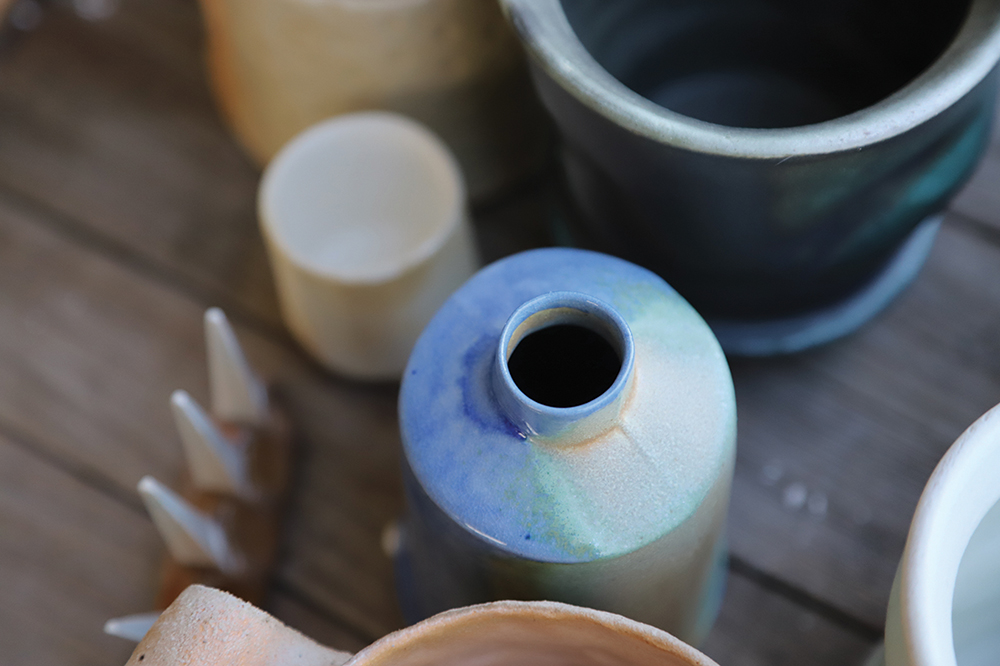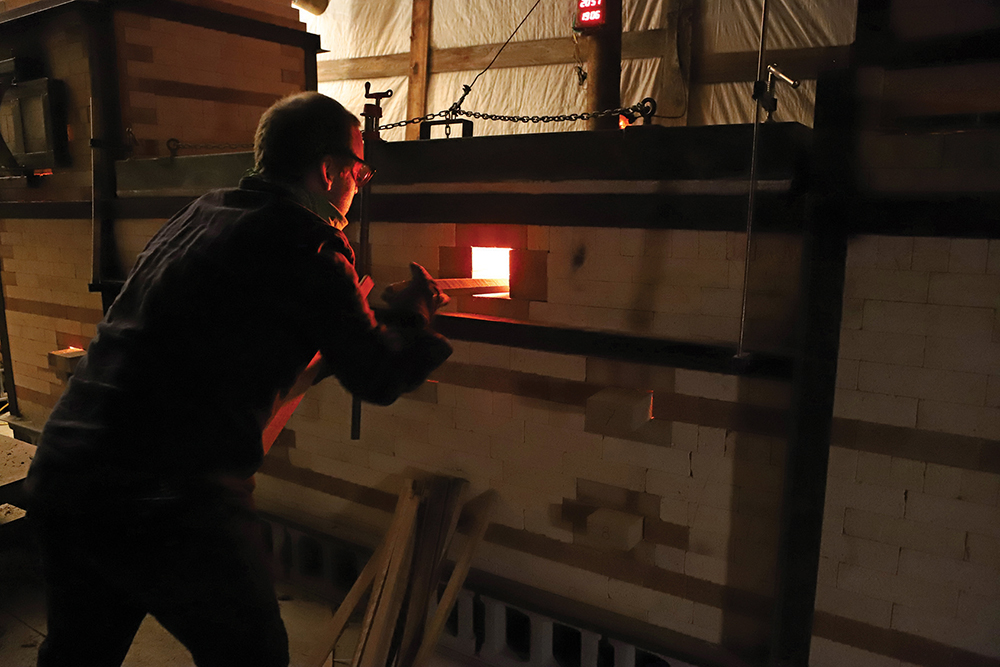An elemental collaboration of ceramic artists Stephen Corner, Heather Dynes Smit, Bruce Cochrane and Andrew Kellner makes magic with clay and wood fire.
By Roger Klein // Photography By Roger Klein
An eruption of glowing embers intermingled with the stars in the night sky each time a log was added to the fire in the kiln. The temperature inside its chambers had gradually climbed above 2,000 degrees Fahrenheit 24 hours after ignition. This was the inaugural firing of the pottery kiln affectionately named “Cherry Blossom,” the creation of ceramic artist Stephen Corner (a.k.a. “Steve the Potter”), who has been a full time potter since 1998.
The Cherry Blossom rests on a cement pad nestled into a wooded area overlooking the Beaver Valley. The kiln is a work of art unto itself, constructed of 3,500 two-toned fire bricks precisely stacked inside a welded steel frame. It’s five metres long and six metres high, with a heavy, brick-lined, hinged door over the fire box. An electric winch opens and closes a large steel-reinforced lid that covers the main ware chamber.
The inferno burning inside must be carefully managed for at least 48 hours and reach a peak temperature of 2,400 F so the mineral and organic molecules can meld with each other and stick to the pottery inside.
“It tells a story of wood and fire with basic elements being left behind on the pottery,” Corner says, explaining that the wood fire always adds an element of mystery to each piece. “You can control it to some degree, but for me that’s the exciting part, to not always know what you are going to get.”
Pottery kilns are usually electric or fuelled by natural gas. Achieving and maintaining the necessary extreme temperatures in a wood-burning kiln is too much work for any one person. Ceramic artists Heather Dynes Smit, Andrew Kellner and Bruce Cochrane all travelled to Corner’s rural property to collaborate and help feed the dragon for the duration of the firing.
“They are all wood-fire potters who are dedicated to putting in the time—to prep wood when we’re not firing, cutting and splitting wood, staying up all night to fire the kiln, bringing food, and we all hang together for a few days and melt trees onto pottery,” says Corner.
The four artists are all heavily invested in the process. They each have dozens of pottery pieces carefully stacked on top of one another inside the ware chamber of the kiln.
They also brought along their own hopes and expectations, but it’s anybody’s guess what will really happen when the flames flow from the fire box, through the ware chamber to the chimney, licking each piece of pottery on its passage through the kiln.
“With wood-fired pottery you really see the evidence of the process, you see how the flame pattern works its way around the pot, leaves marks on the pot, the wood ash, etcetera,” says Bruce Cochrane, who operates his own wood-fired kiln in Grey Highlands. He is the group’s most experienced artist with wood firing techniques. The professor emeritus of ceramics at Sheridan College says building an appreciation of the art form comes from understanding the process. “If someone is looking at a wood-fired piece (and they) know nothing about it, you would have to explain those details.”
Cochrane and the others all take shifts loading logs into the firebox and smaller pieces of wood into narrow openings spaced throughout the ware chamber. They rely on each other to do their individual parts and all have a hand in the final results.
Andrew Kellner spent months working alone in his studio creating much of the pottery inside the kiln. He says it’s really the gathering of like-minded friends that fuels his creative energy. “The best part is the evening dinners with friends while we are firing and getting together with people I haven’t seen in months.”
Indeed, on this night, a potluck approach to the food and drinks created a parallel collaboration in the space and time spent around the kiln. Conversation and questions filled the air as curious visitors passed through. The hours slipped into the past and the final night shift would fall on Heather Dynes Smit’s shoulders. Smit started her artistic training in metalwork and uses a pattern-making approach in her ceramics. She was anticipating metallic rust colours and textures on her porcelain pieces piled inside the kiln and was ready to embrace the starry night alone, stoking the fire.

“There’s just something
magical about the night
shift, the wood and the light
and heat and you’re surrounded
by darkness and this big,
warm kiln,” says Smit.
“There’s just something magical about the night shift, the wood and the light and heat, and you’re surrounded by darkness and this big, warm kiln,” says Smit.
The following day the coals were allowed to burn down. The final act was to spray the fire with a mixture of sodium bicarbonate and water. The sodium solution extinguishes the fire and gives the pottery a glassy finish. It would take several days for the kiln to cool off. The team would wait until the following weekend to look inside.
“I didn’t peek. Nobody could believe that I didn’t peek. Peeking just leads to more peeking which leads to opening the lid and going for it, so I didn’t peek,” Corner says. He managed to control his curiosity so that everyone involved could be present for the moment of truth, when the lid was lifted off the ware chamber.
After some initial oohs and ahhs and a period of gazing into the kiln from the sidelines, the pieces got lifted out one by one, inspected, gently caressed and then lined up on nearby tables.
The items closest to the firebox had the largest buildup of glaze while other pieces closer to the chimney had a drier look. There were a few that tipped inside the kiln and became fused in a molten marriage to the next item in the stack.
Corner embraces the chaotic forces of nature that wrestle inside the flames. “There is a high rate of loss, especially early when you are learning a kiln, so the takeaway is you get some beautiful results and it’s a combination of earth materials and fire. It’s basically the elements the earth is made of.”
The artists carefully load their wares into boxes padded with bubble wrap, paper and dirty laundry from the weekend. Once back at their individual studios there is more work to do grinding and polishing any lumps and bumps off the individual pieces.
Before departing, the dates are set for the next firing of Cherry Blossom.
“There is always next time, and that’s what keeps us all going,” says Corner. “We all admire our pots for a while. We are actually anxious to get back into the studio to make more pots and do it again.”
Stephen Corner (@corner_stephen, Instagram) sells his works through the Clarksburg ArtBank Collective, the Karger Gallery, Ravine Vineyard, a small gallery at his studio and local art shows. The works of collaborating artists can be found online at generalfinecraft.com.





















